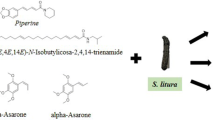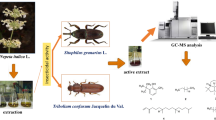Abstract
Bitter lupins (Lupinus spp.) are not used as a protein source because of their toxicity. However, they may have alternative uses as potential sources of natural insecticides. Quinolizidine alkaloids (QA) of three Mexican Lupinus species (Fabaceae): L. montanus (HBK), L. stipulatus (Agardh) and L. aschenbornii (Schauer), were analyzed by capillary Gas Chromatography-Mass Spectrometry. Sparteine was found in high amounts in both L. montanus and L. aschenbornii while the major alkaloids in L. stipulatus extract were aphylline and an epiaphylline-like compound. Alkaloid extracts were tested for their insecticidal activity using larvae of the Fall Armyworm, Spodoptera frugiperda (Smith); (Lepidoptera, Noctuidae) as a model pest. We compared LD50 values and mean weight of caterpillars fed with alkaloid extracts of the three species studied with those of sparteine, a widespread QA found in various lupin species. Extracts of L. montanus and L. aschenbornii were found to be as effective as sparteine and extracts L. stipulatus were found to be the most toxic against the larvae of S. frugiperda. This suggests that the various QA act differently on caterpillars, and could be used to control Spodoptera populations.

Similar content being viewed by others
Abbreviations
- GC-MS:
-
Gas Chromatography coupled with Mass Spectrometry
- LD50 :
-
Lethal Dose killing 50% of individuals
- MS:
-
Mass Spectrometry
- QA:
-
Quinolizidine Alkaloid
- RI:
-
Kovats Retention Index
References
Avila MJA, Mendoza RJL (1981) Guía para cultivar maíz de temporal en la parte alta del estado de Morelos. Campo Agrícola Experimental de Zacatepec, SARH, INIA, CIAMEC, CAEZACA. Zacapetec, Morelos, México
Berkov S, Sidjimova B, Evstatieva L, Popov S (2004) Intraspecific variability in the alkaloid metabolism of Galanthus elwesii. Phytochemistry 65:579–586
Berkov S, Doncheva T, Philipov S, Alexandrov K (2005) Ontogenetic variation of the tropane alkaloids in Datura stramonium. Biochem Syst Ecol 33:1017–1029
Bermúdez-Torres K (1998) Vorkommen und Verbreitung der Lupinen in Mexiko. In: Wink M (ed) Lupinen in Forschung und Praxis. Universität Heidelberg, Heidelberg, Germany, pp 27–40
Bermúdez-Torres K, Robledo Quintos N, Martínez Herrera J, Tei A, Wink M (1999) Patrón de acumulación de alcaloides en hojas y semillas de L. aschenbornii crecidos en México. Revista Latinoamericana de Química 27(3):101–105
Carey DB, Wink M (1994) Elevational variation of quinolizidine alkaloid contents in a in lupin (Lupinus argenteus) of the Rocky Mountains. J Chem Ecol 20:849–857
Coldham I, Dufour S, Haxell TF, Venall G (2005) Dynamic resolution of N-alkyl-2-lithiopyrrolidines with the chiral ligand (−)-sparteine. Tetrahedron 61:3205–3220
De la Vega R, Gutiérrez MP, Sanz C, Calvo R, Robredo LM, de la Cuadra C, Múzquiz M (1996) Bactericide-like effect of Lupinus alkaloids. Ind Crop Prod 5:141–148
De Schamphelaere KAC, Vasconcelos FM, Allen HE, Janssen CR (2004) The effect of dissolved organic matter source on acute copper toxicity to Daphnia magna. Environ Toxicol Chem 23:1248–1255
Franco-Archundia S, Jiménez-Pérez A, Luna-Leon C, Figueroa-Brito R (2006) Efecto tóxico de semillas de cuatro variedades de Carica papaya (Caricaceae) en Spodoptera frugiperda (Lepidoptera: Noctuidae). Folia Entomologica Mexicana 45:171–177
Garcia Lopez PM, Muzquiz M, Zamora Natera NJF, Burbano C, Pedrosa MM, Cuadrado C (1999) Lupanine and sparteine content in three Mexican wild lupin species. In: Van Santen E, Wink M, Weissmann S and Roemer P (eds) Lupin, an ancient crop for the new millenium. Proceedings of the 9th International lupin conference. Klink/Müritz, Germany. International Lupin Association, Canterbury, New Zealand
Gegear RJ, Manson JS, Thomson JD (2007) Ecological context influences pollinator deterrence by alkaloids in floral nectar. Ecol Lett 10:375–382
Gross R (1982) El cultivo y la utilización del tarwi (Lupinus mutabilis Sweet). Estudio FAO No. 36. Producción y protección vegetal, Roma
IENICA (Interactive European Network for Industrial Crops and their Applications) (2002) Lupinus. www.ienica.net/crops/lupins.pdf
Kinghorn AD, Balandrin MF (1984) In: Pelletier WS (ed) Alkaloids: chemical and biological perspectives, vol 2. Wiley Chichester, pp 105–148
Korcz A, Markiewicz M, Pulikowska J, Twardowski T (1987) Species-specific inhibitory effects of lupine alkaloids on translation in plants. J Plant Physiol 128:433–438
Legal L, Moulin B, Jallon JM (1999) The relation between structures and toxicity of chemotaxis of oxygenated aliphatic compounds homologous to the insecticide octanoic acid for two species of Drosophila. Pesticide Biochem Physiol 65:90–101
Meißner C, Wink M (1992) GC/MS-Analyse von Alkaloiden nordamerikanischer Lupinen. In: Wink M (ed) Lupinen 1991- Forschung, Anbau und Verwertung. Universität Heidelberg, Heidelberg, Germany, pp 91–129
Múzquiz M, Cuadrado C, Burbano C, Calvo R, De La Cuadra C (1994) Herbicide-like effect of Lupinus alkaloids. Ind Crop Prod 2:273–280
Nowacki E (1963) Inheritance and biosynthesis of alkaloids in lupin. Genetica Polonica 7(2):34–48
Paolisso G, Nenquin M, Schmeer W, Mathot F, Meissner HP, Henquin JC (1985) Sparteine increases insulin release by decreasing the K+ permeability of the B-cell membrane. Biochem Pharmacol 34(13):2355–2361
Pilat P, Votruba J, Dobersky P, Prokop A (1976) Application of mathematical optimization methods in microbiology. Folia Microbiol 21:391–405
Regnault-Roger C (1997) The potential of botanical essential oils for insect pest control. Integr Pest Manag Rev 2:25–34
Reyes-Chilpa R, Rivera J, Oropeza M, Mendoza P, Amekraz B, Jankowski C, Campos M (2004) Methanol extracts of Hamelia patens containing oxindole alkaloids relax KCl-induced contraction in rat myometrium. Biol Pharm Bull 27:1617–1620
Singaravelan N, Nee’man G, Inbar M, Izhaki I (2005) Feeding responses of free-flying honeybees to secondary compounds mimicking floral nectars. J Chem Ecol 31:2791–2804
Tyski S, Markiewicz M, Gulewicz K, Twardowski T (1988) The effect of lupin alkaloids and ethanol extracts from seeds of L. angustofolius and selected bacterial strains. J Plant Physiol 133(2):240–242
Usmani KA, Knowles CO (2001) Toxicity of pyrethroids and effect of synergists to larval and adult Helicoverpa zea, Spodoptera frugiperda, and Agrotis ipsilon (Lepidoptera: Noctuidae). J Econ Entomol 94(4):868–873
Wink M (1983) Inhibition of seed germination by quinolizidine alkaloids. Aspects of allelopathy in Lupinus albus L. Planta 158:365–368
Wink M (1984a) Chemical defense of Leguminosae. Are quinolizidine alkaloids part of the antimicrobial defense system of lupins? Z Naturforsch 39c:548–552
Wink M (1984b) Biochemistry and chemical ecology of lupin alkaloids. In: Proceedings of the 3rd international lupin conference. La Rochelle, pp 326–343
Wink M (1987) Quinolizidine alkaloids: biochemistry, metabolism, and function in plants and cell suspension cultures. Planta Med 53:509–514
Wink M (1988) Plant breeding: importance of plant secondary metabolites for protection against pathogens and herbivores. Theor Appl Genet 75:225–233
Wink M (1992) The role of quinolizidine alkaloids in plant-insect interactions. In: Bernays EA (ed) Insect-plant interactions, vol IV. CRC-Press, Boca Ratón, pp 131–166
Wink M (1993) Quinolizidine alkaloids. In: Waterman P (ed) Methods in plant biochemistry, vol 8. Academic Press, London, pp 197–239
Wink M (1994) Biological activities and potential application of lupin alkaloids. In: Neves-Martins JM, Beirao da Costa ML (eds) Advances in lupin research. ISA press, Lisboa, pp 161–178
Wink M, Legal L (2001) Evidence for two genetically and chemically defined host races of Tyria jacobaeae (Arctiidae, Lepidoptera). Chemoecology 11:199–207
Wink M, Theile V (2002) Alkaloid tolerance in Manduca sexta and phylogenetically related sphingids (Lepidoptera: Sphingidae). Chemoecology 12:29–46
Wink M, Twardowski T (1992) Allelochemical properties of alkaloids. Effect on plants, bacteria and protein biosynthesis. In: Rizvi SJH, Rizvi V (eds) Allelopathy: basic and applied aspects. Chapman and Hall, London, pp 129–150
Wink M, Witte L, Schiebel MH, Hartmann T (1980) Alkaloid pattern of cell suspension cultures and differentiated plants of Lupinus polyphyllus. Planta Med 38:238–245
Wink M, Witte L, Hartmann T (1981) Quinolizidine alkaloids of cell suspension cultures and plants of Cytisus (Sarothamnus) scoparius and of its root parasite Orobacnhe rapum-genistae. Planta Med 43:342–352
Wink M, Hartmann T, Witte L, Rheinheimer J (1982) Interrelationship between quinolizidine alkaloid producing legumes and infesting insects: exploitation of the alkaloid-containing phloem sap of Cytisus scoparius by the Broom aphid (Aphis cytisorum). Z Naturforsch 37c:1081–1086
Wink M, Witte L, Hartmann T, Theuring C, Volz V (1983) Accumulation of quinolizidine alkaloids in plants and cell suspension cultures: genera Lupinus, Cytisus, Baptisia, Genista, Laburnum and Sophora. Planta Med 48:253–257
Wink M, Meißner C, Witte L (1995) Patterns of quinolizidine alkaloids in 56 species of the genus Lupinus. Phytochemistry 38:139–153
Wink M, Legal L, von Nickisch-Rosenegk E (1998) How not to use systematics to test adaptative hypothesis. J Chem Ecol 24:1285–1291
Wippich C, Wink M (1985) Biological properties of alkaloids. Influence of quinolizidine alkaloids and gramine on the germination and development of powdery mildew, Erysiphe graminist f.sp.hordei. Experientia 41:1477–1479
Acknowledgements
Peter Winterton is thanked for his help in correcting English. This study was supported by CONACYT (26411-N) and CGPI (978038). Laura Lina is greatly thanked for providing Spodoptera frugiperda eggs.
Author information
Authors and Affiliations
Corresponding author
Additional information
Handling editor: Samantha Cook.
Rights and permissions
About this article
Cite this article
Bermúdez-Torres, K., Martínez Herrera, J., Figueroa Brito, R. et al. Activity of quinolizidine alkaloids from three Mexican Lupinus against the lepidopteran crop pest Spodoptera frugiperda . BioControl 54, 459–466 (2009). https://doi.org/10.1007/s10526-008-9180-y
Received:
Accepted:
Published:
Issue Date:
DOI: https://doi.org/10.1007/s10526-008-9180-y




